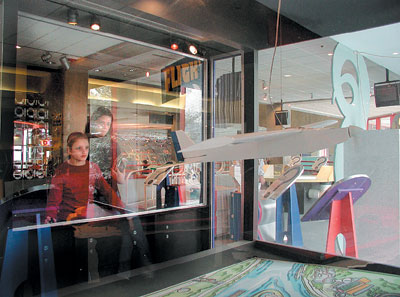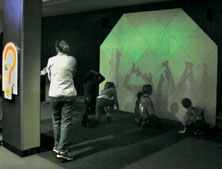SciQuest Revisited
By R.J. Gangwere

Developed
to meet the needs of middle-school (grades 5 to 8)
science teachers to better educate their students,
SciQuest remains one
of Carnegie Science Center’s strongest interactive exhibitions. “That’s
about three million
visitors — or 6 million hands, pushing, pulling, turning and experimenting
with the exhibits,” says Dennis Bateman, assistant director for Exhibits
at Carnegie Science Center, and the project director. “There are certainly
favorites, that we would never change, like the Earthquake Café, he says,
but then adds that not too long ago SciQuest got a little “boost” with
redesigned activities so that loyal visitors who have been there many times will
have new experiences. The Grable Foundation, which originally funded SciQuest,
supported
its renewal.
SciQuest benefits 125,000 students who visit
Carnegie Science Center each year in school groups.
This is a significant part of the total attendance
of 650,000
visitors, which consists mainly of families of all
ages. On the Science Center website, the public can
get Exhibit Guides prepared by the education staff,
which allow teachers, homeschoolers and families to
retrieve and print versions of the
classroom teaching guide as needed.
Many middle-school
teachers develop classroom activities in relation
to a SciQuest visit. For example, students and teachers
can design and build structures in class
that they bring to the Earthquake Table to see if
their architecture is earthquake-proof. Or after
discussing
heat waves in class, they can use an infrared camera
at SciQuest to compare heat waves given off by a
can of Coca-Cola in an insulated holder, or when
standing alone.
For Dennis Bateman, one satisfaction
of SciQuest is seeing how people who do not know
each other enjoy
working together at an activity. In “Shadow
Catcher,” for
example, visitors enjoy each other’s shadows
as they are “frozen” in a flash of
light on a phosphorescent wall—by using the
same chemical processes used to make glow-in-the-dark
stickers or
emergency exit signs. And children and adults alike
team up in Volcano! to pump gasses and “lava” up
through a 10-foot-high cutaway slice of a volcano
to produce a spectacular eruption.
 A goal of SciQuest is to allow visitors to experience activities
not available in school, at home, or at any other institution.
Where
else but at Wheel… of…Disaster! could
you spin a rotating “pie chart” to
see your chances of dying in a natural disaster
in the United
States in any given year, or your chances of
being struck by lighting, or washed away in a
flood? At SciQuest,
it’s fun to find out. A goal of SciQuest is to allow visitors to experience activities
not available in school, at home, or at any other institution.
Where
else but at Wheel… of…Disaster! could
you spin a rotating “pie chart” to
see your chances of dying in a natural disaster
in the United
States in any given year, or your chances of
being struck by lighting, or washed away in a
flood? At SciQuest,
it’s fun to find out.
Back to Contents |